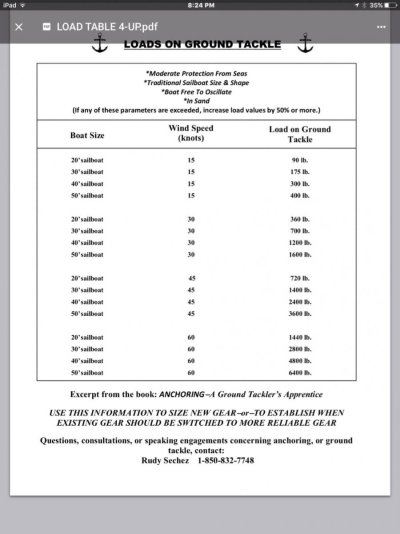ksanders
Moderator Emeritus
I was thinking the other day, that with my all chain rode, just how much wind would it take to even lift the rode off the sea bed so that it is a relativly straight line to the boat.
I know this is a difficult to calculate subject, but I have suspected based on the mud clinging to my anchor rode that it just sits on the sea bed most of the time.
So I thought, If I was anchor'd in 100' of water, and deployed a 4:1 scope of 400' of chain, just how much force would need to be exerted on my boat to lift that chain from the sea bed.
Math gurus, please help me out here, but my basic thought is if the chain weighs 1.17 lbs per foot, and I have a water depth of 100', and have 400' or chain deployed then.
Just sitting there, no wind there is 300' of chain on the sea bed to lift so to me that requires a force of 300' * 1.17 lbs per foot or approx 350 pounds.
Then I tried to calculate wind force. That is impossible for me so I tried to guesstimate the equlivent square footage of the frontal area of my boat. My guess is 150-200 square feet.
So the handy dandy wind loading calculator I found online shows a 30 mph wind producing approx 370 pounds of force at 30 knots on a 200 sqft frontal area.
So... It looks to me that in a 30 knot wind my anchor chain might be just getting lifted off of the sea bed.
Now, the math geniuses, please fix my simplistic calculations and tell me how much wind is REALLY required to lift my anchor rode off the sea bed.
I know this is a difficult to calculate subject, but I have suspected based on the mud clinging to my anchor rode that it just sits on the sea bed most of the time.
So I thought, If I was anchor'd in 100' of water, and deployed a 4:1 scope of 400' of chain, just how much force would need to be exerted on my boat to lift that chain from the sea bed.
Math gurus, please help me out here, but my basic thought is if the chain weighs 1.17 lbs per foot, and I have a water depth of 100', and have 400' or chain deployed then.
Just sitting there, no wind there is 300' of chain on the sea bed to lift so to me that requires a force of 300' * 1.17 lbs per foot or approx 350 pounds.
Then I tried to calculate wind force. That is impossible for me so I tried to guesstimate the equlivent square footage of the frontal area of my boat. My guess is 150-200 square feet.
So the handy dandy wind loading calculator I found online shows a 30 mph wind producing approx 370 pounds of force at 30 knots on a 200 sqft frontal area.
So... It looks to me that in a 30 knot wind my anchor chain might be just getting lifted off of the sea bed.
Now, the math geniuses, please fix my simplistic calculations and tell me how much wind is REALLY required to lift my anchor rode off the sea bed.


